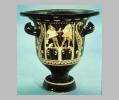Hide browse bar Your current position in the text is marked in blue. Click anywhere in the line to jump to another position:
chapter:
Introduction to the Historical Overview in Perseus
Geographical and Historical Introduction
The Early Greek Dark Age and Revival in the Near East
Remaking Greek Civilization
The Archaic Age
The Late Archaic City-State
Introduction to the Fifth Century
Clash Between Greeks and Persians
Athenian Empire in the Golden Age
Athenian Religious and Cultural Life in the Golden Age
Continuity and Change in Athenian Social and Intellectual History
The Peloponnesian War and Athenian Life
Introduction to the Fourth Century
The Aftermath of the Peloponnesian War
New Directions in Philosophy and Education
The Creation of Macedonian Power
section:
This text is part of:
View text chunked by:
Table of Contents:
 Clash Between Greeks and Persians
Clash Between Greeks and Persians
 Athenian Empire in the Golden Age
Athenian Empire in the Golden Age
 Athenian Religious and Cultural Life in the Golden Age
Athenian Religious and Cultural Life in the Golden Age
 Continuity and Change in Athenian Social and Intellectual History
Continuity and Change in Athenian Social and Intellectual History
 The Peloponnesian War and Athenian Life
The Peloponnesian War and Athenian Life

The Annenberg CPB/Project provided support for entering this text.
Purchase a copy of this text (not necessarily the same edition) from Amazon.com
show
Browse Bar
hide
Places (automatically extracted)
View a map of the most frequently mentioned places in this document.
Download Pleiades ancient places geospacial dataset for this text.
hide
Search
hide
Display Preferences



